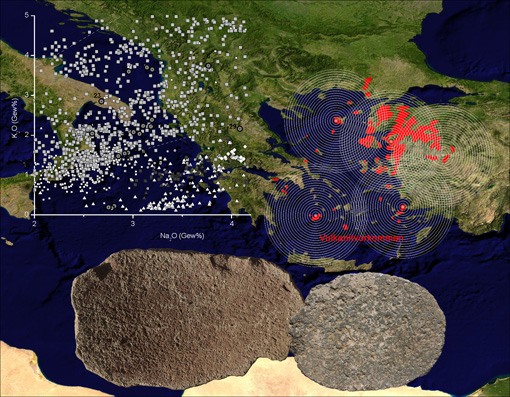Milling Technologies and Procurement Systems
Grinding stones are common settlement finds on prehistoric excavations. Rocks with favourable material properties were selected for the devices among all types of rock (igneous, metamorphic, sedimentary rocks). The archaeological advantage of volcanic rocks lies in their geochemical properties, which can be used to determine their provenance and reveal raw material procurement strategies.
With the spread of Neolithic agriculture, the preparation of grain became an integral part of everyday life. In prehistoric times, both grinding stones and mortars were used for food preparation, whilst crushing grain was performed mainly with grinding stones. According to the current state of research, two technical innovations – the so-called Olynthus Mill and the rotary quern – cannot be detected in the Mediterranean area before about the middle of the 1st millennium BC. The more efficient rotary querns were finally perfected in Roman times and since then they became the preferred device for grain processing.
Grinding stones and mortars are common settlement finds on prehistoric excavations. Rocks found in the immediate environment were most often used for their production. Rocks with favourable material properties were selected for the devices among all types of rock (igneous, metamorphic, sedimentary rocks). Volcanic rocks are particularly suitable as a raw material for grinding stones. The archaeological advantage of volcanic rocks lies in their geochemical properties, which can be used to determine their provenance.
Even in regions where no suitable materials such as volcanic rocks are found in the immediate vicinity of a settlement, such everyday devices are still found in settlement contexts, produced from non-local rocks. This indicates an intentional supply of raw materials or finished objects in prehistoric times. The artefacts of volcanic material offer the possibility of a provenance determination based on petrographic and geochemical analyses. Their major and trace element signatures in combination with a comparison to known data from volcanic regions can thus reveal local and inter-regional procurement systems.
Research on grinding stones from the excavations of the German Archaeological Institute in the Greek colony of Selinunte in Sicily (late 7th until middle of the 3rd century BC) is already completed.
Studies on grinding stones from prehistoric sites in western Anatolia (Çukuriçi Höyük, Survey of the prehistoric surroundings of Pergamon) as well as southern Italy (Punta di Zambrone) are currently underway. Communication and exchange networks in prehistoric times will be illuminated with the help of geochemical provenance analysis.
